While the people of Bhopal wallow in chemical sludge, Dow diligently continues to buy influence at colleges and universities across the country with giveaways that now total more than $60 million. Find out whether your university accepts funding from Dow; if so, tell your university to turn it down until Dow gets its priorities straight.
Why not? It’s not as though Dow holds students in particularly high regard. And really, do we want Dow – a company with a long and ugly history of chemical terror – associated with our institutions of learning? Should our schools be tarnished by Dow’s profiteering from human suffering and slaughter? Till date, Dow’s giveaways to colleges and universities have totaled more than $60 million. That kind of money buys a lot of influence. And while the projects Dow funds may not themselves always be objectionable – who can complain about a nice lecture now and then? – we shouldn’t have to measure the cost in human life. The fact that Dow has not acted to stop the ongoing contamination of tens of thousands - for which it is responsible - is inhumane, unjust, and immoral. Dow’s evasion of responsibility in Bhopal means that another life is lost each day, and there’s no reason why our schools should be complicit in the crime by accepting Dow’s blood money. Our schools don’t accept drug money. No doubt they’d
turn down a check from Saddam Hussein, the man who ordered the chemical
weapons attack on the Kurdish city of Halabja (killing an estimated
5,000 people). Why should our schools condone the chemical terror
which Dow-Carbide continues to perpetuate in Bhopal? It’s
a question worth asking. And while your school may be reluctant
to take action, other schools are already doing so: for example,
the University
of Arizona, which has an official policy regulating its association
with corporations on ethical grounds. Sixty million dollars is a lot of money. Obviously Dow feels buying influence at schools across the country is important – more important, apparently, than human life itself. The extent of Dow’s involvement with our institutions of learning implies their importance: colleges and universities are a central strategic, reputational, and financial interest to Dow. By threatening Dow’s presence at schools across the country, we pose a significant threat to Dow’s business interests: a similar student movement 30 years ago successfully forced Dow to end its production of napalm for the US military.
Vision Goals Strategies
Alternately, you can organize a “quarantine” of the building. Dress in white biohazard suits and white face masks and advise students that entry into the building might be unsafe, given Dow's history of environmental contamination. If you’re really creative, you can borrow a projector, design a skull and crossbones slide, and project it onto your campus Dow building.
Rather than assigning a few people to sit at a table and collect signatures, it’s more efficient for everyone in the group to get in on the act, and collect 20 or so signatures per week (or more if you can) from friends, folks in their dorms, etc. Give people a basic rap to say, hand out the blank petitions at a meeting and send them off! As with other kinds of sign-up sheets, it’s good to put yourself and a few friends at the top of the sheet so nobody has to be the first. Keep the original petition and send copies of it to your target(s). Add everyone who signs up to a low-traffic “action alert” email list, so that they’ll know about other opportunities to support your efforts.
One possibility: sketch body outlines around campus (particularly around the Dow Building, if you have one, or the President’s house) and write the names of Bhopal victims inside, or Bhopal slogans.
..........• The standard of proof
is lower. The Grand Jury simply needs to conclude that a "preponderance
of the evidence" suggests that a party is guilty. A conviction
requires reasonable doubt. The whole process is interactive theater from start to finish, and it lends itself to media coverage: "Blah University Students Indict $40 Billion Company for Corporate Manslaughter". You can even give interviews "in character" as the prosecutor or as a juror.
A creative twist: befoul (but do no damage to) a public fountain. Dress up as Dow executives and angrily assert that the water is clean, and fine for drinking. Refuse to drink the water yourselves but insist that others do so.
Develop a sensible time-line and make sure everything gets done on time, with people assigned to specific tasks - as usual, you can do a good job at a reasonable pace with a lot of people, or a bad job frantically with just a few. It’s especially important to have some last-minute advertising the day of the rally - chalk on the sidewalks the night before, leaflet the day of, etc. Rallies usually begin with a short introduction by an MC and then
a series of speeches, chants, music, and so on. Some things to help
rallies go well: Press tips:
You should NOT hold a sit-in until you have worked through the initial stages of educating people and holding one or more protests. A sit-in is a last resort, and should not be done out of the blue. However if, after having worked on an issue for a long time, you’re hitting your head against a brick wall, then the time might be ripe for a sit-in. You’ll need a core group of people to start the effort. Organize a series of meetings over the course of which you introduce and discuss the sit-in option. Don’t force reluctant people to commit, but over a couple weeks build up a list of people willing to sit-in. Get them to sign a pledge and repeatedly verify that they are comfortable doing so. Aim for group consensus on the decision to sit-in. Members who do not want to sit-in will hopefully be supportive of those who do, and you need some activists on the outside to organize rallies in your support. Discuss what you’ll do if security tells you to leave. Scout out the site. It should be strategic (a site of power), ideally near the center of campus (where you can gather supporters), and large enough to accommodate your group of people for a couple days or more. To avoid security stopping you before you can get in the building, you should keep the discussion of doing a sit-in off all email lists (especially details of date and time). Rely upon word-of-mouth, calling people and group meetings.
Here’s a list of things to bring: You might have the freedom to come and leave, in which case you can arrange to deliver assignments and stay on top of your courses. Leave the space neat and tidy. Don’t punish the underpaid secretaries and janitors who will have to clean up any mess you leave. ..........• Handouts
and fact sheets about Bhopal
In the fall of 2002, a small group of students came together at the University of Michigan to form the first campus campaign for Justice in Bhopal. We knew that we wanted to pressure Dow by challenging its relationship to the University of Michigan, and since Dow, a $40 billion company, was headquartered only an hour and a half away, we figured that Dow might have a significant presence at our school. But first we had to figure out what it was. We started our research in October of 2002. Our task was made easier by the fact that our school was a public institution, so the first thing that we did was to file an open records request. A few of us had had previous experience filing requests, and we knew where within the University the requests should be filed. In the meanwhile, we began an intensive search of the school’s website, using a wide variety of search terms designed to bring up any articles, press releases or websites that might reveal the extent of the University’s relationship with Dow. This part was tedious; usually research is, but we uncovered a treasure trove of material. Leading University officials had been quoted publicly saying such things as “We are grateful to Dow - for their generosity, for their support, and for their trust.” Trust? Our school was grateful for Dow’s trust? Obviously Dow’s cash had bought it a lot of influence at the University of Michigan, an unsettling thought given what we knew about Dow. When we received the University’s response to our open records
request a month later, we learned that the University didn’t
own any Dow stock. However Dow was a major contributor
to the University of Michigan (over $12 million, placing it nearly
in the top 25 all-time donors), and its associated foundations had
contributed millions more. It was impressive to see Dow’s
name on campus buildings, but But what? We put our heads together and crafted a plan of action. Armed with our new knowledge, we approached the Michigan Daily, our campus newspaper, and they agreed to do a feature on Dow, Bhopal, and the University’s ties to both. Eventually, this feature (published in January, 2003) grew to a sprawling full-page spread, and included six full articles, several of them written by us. It caused a major stir when it was published, and gave added momentum to our campaign. In the meanwhile, we drafted a resolution that we planned to submit to the Michigan Student Assembly (MSA) which called on the University to refuse future donations from Dow until Dow began spending an equivalent amount to clean up Bhopal. We chose this strategy because we felt it was critical that we have demonstrable support from students for our cause – asking the University to refuse free money is a controversial thing, and we didn’t want to negotiate with the university without being able to say that we had the students on our side. Garnering some measurable example of student support would also make it easier for us to ask faculty for their support – we understood that on the University totem pole, students were ranked rather low, but we didn’t think that many faculty would support our campaign without having the excuse of widespread student support. Drafting the resolution was one thing; gathering support was another. We chose a two-pronged approach. On the one hand, we’d ask regular students crossing the Diag (our campus crossroads) to sign a petition endorsing the resolution. On the other hand, we decided to approach other student groups and ask to speak about the resolution at their next meeting. Most student groups were more than willing to give us five minutes of their time, and we found that talking about Bhopal and the resolution served two purposes: first, student groups of all stripes (even musical, athletic, and conservative political groups) were willing to sign on; second, and more importantly, we were reaching out to active students throughout the university. While most were supportive, there were a few, usually one or two per group, who were outraged, and wanted to get further involved. Of course we told them to come to our weekly meetings and within a few weeks our meetings were huge, and represented a broad spectrum of students across the university. On March 17, 2003, when the resolution came due for a vote before the Student Assembly, we were ready. Fully 28 student groups had signed on in support – unheard of for a student resolution – and 700 individual students had signed petitions in support. Several faculty members had signed on in support as well, and we’d lined up thirteen students – at 5 minutes each – to speak in favor of the resolution. As it happens, we were lucky that the support was so overwhelming. Dow had heard about our resolution and they weren’t happy. In fact, they had their head of Public Relations take time away from dealing with Agent Orange, dioxin, nemagon and Dow’s other scandals to focus his time on us. Unbeknownst to us, Dow had obtained a copy of our resolution and had developed slick rebuttals line by line – rebuttals that were no less slick or persuasive for being lies. These were read out in front of the Student Assembly, and if our support had been less substantial (or if we’d had fewer people there to explain how Dow was lying) we could easily have lost the vote. In the end it was close – 13 in favor, 10 voting against, with 7 abstentions. But we won! Dow was defeated and we celebrated. From the start, we understood that it would be impossible to end Dow’s influence within a single school year. When we began the campaign no one knew about Bhopal or why it was important. By the end of the year Dow was afraid to show its face on campus lest we organize a protest (they learned this the hard way). Professors and Deans within several schools were privately questioning Dow’s influence in their departments and whether it should continue. Senior University officials were in closed-door discussions with Dow about our campaign, we learned. Only one thing stood in the way of ultimate success: graduation. With newer blood, we could have carried on the campaign the following year, building faculty and community support and making Dow’s influence at the University politically untenable. But our group made the cardinal error that so many campus groups do: the leaders were all seniors! Graduation was like a decapitation, and instead of starting where we had left off next fall, the group started back at square one. Despite that painful lesson, others are hopeful. Within one year it is possible to build widespread awareness and outrage about Bhopal. It is possible to challenge Dow’s influence at our schools, and to pose a threat by doing so. It is possible to defeat them in battle – with time, a smart strategy, and a strong group it is possible to win. Now, it’s your turn! Questions? Email Ryan!
|
The international student campaign to hold Dow
accountable for Bhopal, and its other toxic legacies around the world.
For more information about the campaign, or for problems regarding this
website, contact Ryan
Bodanyi, the Coordinator of Students for Bhopal.
WE
ALL LIVE  IN
BHOPAL
IN
BHOPAL
"The year 2003 was a special year in the history of the campaign for justice in Bhopal. It was the year when student and youth supporters from at least 30 campuses in the US and India took action against Dow Chemical or in support of the demands of the Bhopal survivors. As we enter the 20th year of the unfolding Bhopal disaster, we can, with your support, convey to Dow Chemical that the fight for justice in Bhopal is getting stronger and will continue till justice is done. We look forward to your continued support and good wishes, and hope that our joint struggle will pave the way for a just world free of the abuse of corporate power."
Signed/ Rasheeda Bi, Champa Devi Shukla
Bhopal Gas Affected Women Stationery Employees Union
International Campaign for Justice in Bhopal
This is what the www.studentsforbhopal.org site looked like in early 2008. For more recent information, please visit www.bhopal.net.





 nice...
nice...

 nice...
nice... not nice
not nice


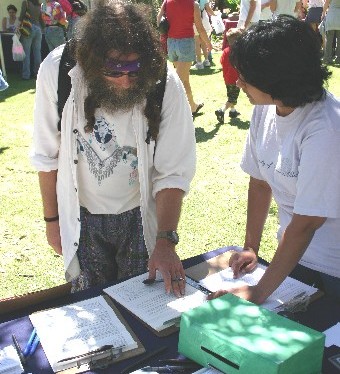
 Alumni
Support
Alumni
Support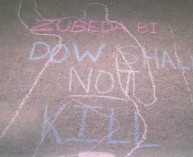
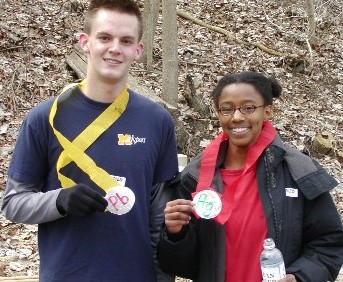
 engaging
and participatory way; drawing attention to the University’s
unacceptable association with Dow, and garnering valuable
publicity for the campaign. Participants were asked to
engaging
and participatory way; drawing attention to the University’s
unacceptable association with Dow, and garnering valuable
publicity for the campaign. Participants were asked to 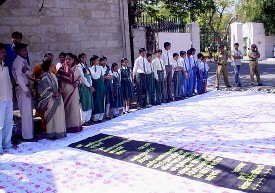
 Put
Dow On Trial
Put
Dow On Trial
 Hand
out “Bhopal Water”
Hand
out “Bhopal Water”
 Leaking
Barrels
Leaking
Barrels Fasts
or Hunger-Strikes
Fasts
or Hunger-Strikes Rallies
Rallies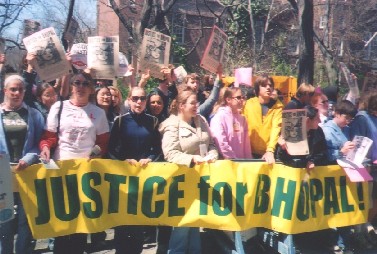
 Banner
Drops
Banner
Drops Sit-Ins
Sit-Ins
 from our research we knew that they only contributed a tiny fraction
– sometimes as little as four or five percent – of the
total building costs. And while lecture series are nice (who doesn’t
enjoy a nice lecture now and then?), we considered it immoral to
accept their money while Dow refused to spend that very same money
to clean up its contamination in Bhopal – from which people
continue to die every day. We decided that something had to be done.
from our research we knew that they only contributed a tiny fraction
– sometimes as little as four or five percent – of the
total building costs. And while lecture series are nice (who doesn’t
enjoy a nice lecture now and then?), we considered it immoral to
accept their money while Dow refused to spend that very same money
to clean up its contamination in Bhopal – from which people
continue to die every day. We decided that something had to be done.